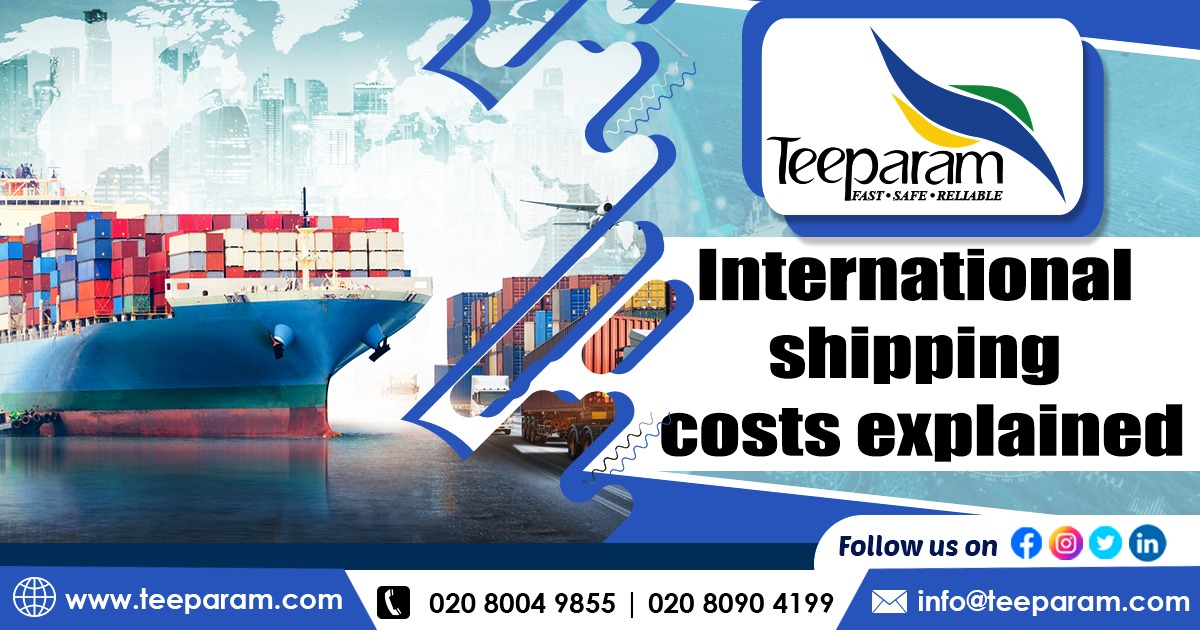International shipping costs is a complex topic. Whether you’re a small business owner sending handmade goods to customers overseas or an individual mailing a care package to a friend on another continent, the costs can feel like a black box—mysterious, unpredictable, and often shockingly high. But there’s a method to the madness. By breaking down the factors that drive international shipping costs, we can demystify the process and help you make sense of what you’re paying for. This article dives into the nitty-gritty of why shipping across borders is so expensive, what influences those costs, and how you can navigate the system to save a few bucks.
The Basics of International Shipping Costs
At its core, international shipping involves moving goods from one country to another, often across vast distances and through multiple modes of transportation—planes, ships, trucks, or even trains. The price you pay reflects the complexity of this journey. Unlike domestic shipping, where costs are relatively straightforward (think distance, weight, and speed), international shipping throws in a host of additional variables: customs duties, taxes, carrier fees, and regulatory compliance. These factors combine to make international shipping a unique challenge, both logistically and financially.
The first thing to understand is that shipping costs are rarely a flat rate. They’re calculated based on a combination of measurable factors (like package weight and dimensions) and less tangible ones (like fuel prices or geopolitical events). Let’s unpack the key components that determine what you’ll see on your shipping invoice.
Key Factors Influencing International Shipping Costs
1. Distance and Destination
The farther your package travels, the more it costs. Sending a parcel from Birmingham to Paris is generally cheaper than shipping to Sydney or Tokyo, due to distance and logistics. For UK shippers, Europe is often more affordable thanks to proximity and EU trade agreements (even post-Brexit, though complexities remain). Shipping to the USA, with its major ports and airports like New York or Los Angeles, can be moderately priced, but remote destinations like rural Canada or island nations like New Zealand are pricier due to limited infrastructure.
For US-based shippers, sending to the UK incurs higher costs than sending to Canada or Mexico because of the transatlantic journey. Similarly, countries like Australia face higher costs due to geographic isolation, while shipping within regions like Southeast Asia can be cheaper due to shorter distances and robust trade networks.
2. Weight and Dimensions
The size and weight of your package are critical. Carriers use dimensional weight (or volumetric weight) to account for the space a package occupies, especially for air freight, which is common for UK-to-USA or transcontinental shipments. Dimensional weight is calculated by multiplying the package’s length, width, and height (in centimetres or inches) and dividing by a factor (often 5,000 for international shipments). The carrier charges based on the higher of the actual weight or dimensional weight.
For example, a lightweight but bulky box of cushions shipped from London to Chicago might cost more than a small, heavy box of books to Berlin. UK shippers can save by using compact packaging, as can US and global shippers, since carriers like Royal Mail, USPS, or DHL apply similar rules.
3. Shipping Method and Speed
How quickly you need your package delivered significantly affects cost. From the UK, options range from economy services (like Royal Mail’s International Economy, taking 6–8 weeks to the USA) to express services (like DHL Express, delivering to New York in 2–3 days). Economy shipping, often by sea, is cheaper—£15–£30 for a 2 kg parcel to the USA—while express air shipping can cost £80 or more.
In the USA, USPS Priority Mail International to the UK takes 6–10 days and costs $40–$60 for a similar parcel, while FedEx International Priority might hit $100 for 1–3 days. Globally, sea freight is cost-effective for bulk shipments to places like Australia, but air freight dominates for speed. If time isn’t critical, choosing slower options can slash costs, whether you’re in the UK, USA, or elsewhere.
4. Customs Duties and Taxes
Customs can be a headache. When shipping from the UK to the USA, EU, or beyond, your package faces duties and taxes based on the destination country’s rules. In the UK, importing goods valued over £135 may incur VAT (20%) and customs duties, which vary by product (e.g., 12% for clothing). The USA has a higher duty-free threshold ($800), but goods like electronics can face tariffs of 2–7%. Other countries, like Canada or Australia, have lower thresholds (C$20 and A$1,000, respectively), meaning recipients often pay extra.
These fees are typically paid by the recipient, but some carriers require the sender to cover them upfront. Post-Brexit, UK-to-EU shipments now face customs checks, adding costs and delays. Researching the destination’s customs policies—whether you’re in Manchester, Miami, or Mumbai—helps avoid surprises.
5. Carrier and Service Fees
Carriers like Royal Mail, DHL, UPS, or USPS set their own rates. In the UK, Royal Mail’s International Standard is affordable but slower, while private couriers like DHL offer speed and tracking at a premium. In the USA, USPS is often the budget option, while FedEx or UPS excel for reliability. Globally, carriers like Australia Post or Japan Post have similar tiers.
Additional fees—like fuel surcharges, remote area delivery (common in rural USA or Australia), or residential address charges—can add up. Optional services like insurance or signature confirmation also increase costs, especially for valuable items like jewellery shipped from London to Los Angeles.
6. Packaging and Handling
Your packaging choices matter. Irregularly shaped goods or fragile items may incur handling fees, whether shipped from the UK, USA, or elsewhere. Using standard-sized boxes and minimizing space reduces dimensional weight charges. Royal Mail and USPS offer free packaging for some services, so check before buying supplies. For hazardous materials (like certain cosmetics), extra fees apply globally due to strict regulations.
7. Fuel Surcharges and Market Conditions
Fuel prices directly impact shipping costs, with carriers adding surcharges that fluctuate with global oil markets. In 2025, ongoing geopolitical tensions have kept fuel costs volatile, affecting UK-to-USA and trans-Pacific routes. Port congestion (like in Los Angeles) or labour shortages (common in the UK) can also drive prices up. These factors are universal but hit harder for long-haul routes.
Hidden Costs and Pitfalls
Unexpected fees can sting. Customs clearance fees (£10–£50) cover paperwork and compliance, whether you’re shipping from London to Toronto or Seattle to Sydney. Currency conversion fees can also creep in if paying in a foreign currency—banks or carriers may apply poor exchange rates. For UK shippers, Brexit has added complexity for EU-bound parcels, with new paperwork requirements inflating costs.
Poor packaging is another trap. A bulky parcel from Manchester to Melbourne could rack up dimensional weight charges, as could one from Dallas to Dublin. Always measure and weigh your package accurately to avoid surprises.
Tips for Reducing International Shipping Costs
Here’s how UK, US, and global shippers can save:
- Pack Smart: Use snug, standard-sized boxes to minimize dimensional weight. This applies everywhere—London, Los Angeles, or Lagos.
- Go Slow: Choose economy shipping for non-urgent parcels. Royal Mail’s International Economy or USPS First-Class Package International can halve costs.
- Know Customs Rules: Check duty thresholds (e.g., £135 for UK imports, $800 for the USA)
- Consolidate Shipments: Businesses can combine orders into one shipment to cut per-parcel costs, whether shipping from the UK, USA, or Asia.
The Bigger Picture
International shipping costs are a balancing act between speed, reliability, and affordability. While it’s tempting to focus solely on the price tag, consider the value of getting your package to its destination safely and on time. For businesses, high shipping costs can erode profit margins, so it’s worth investing time in optimizing your strategy. For individuals, understanding the factors at play can help you make informed choices and avoid sticker shock.
In a globalized world, international shipping is the backbone of cross-border commerce and personal connections. By breaking down the costs—distance, weight, speed, customs, and more—you can navigate the system with confidence. Whether you’re sending a gift to a loved one or scaling an e-commerce empire, a little knowledge goes a long way in taming the wild world of international shipping.
Ship Smarter with Teeparam: Your Cost-Saving Ally in Global Logistics!
In the maze of international shipping—where distance, customs duties, and fluctuating fuel surcharges can quickly inflate costs—Teeparam Logistics stands out as a reliable partner for UK businesses and individuals alike. Specializing in sea, air, and road transportation, Teeparam offers flexible FCL and LCL solutions that align perfectly with the tips we’ve shared in our guide to international shipping costs.
What sets Teeparam apart? Their decade of proven experience ensures safe, secure deliveries without the hidden pitfalls like excessive dimensional weight fees or surprise clearance charges. Whether you’re shipping from London to Los Angeles or Birmingham to Berlin, their tailored, affordable pricing helps optimize your supply chain, delivering cost savings and on-time reliability every time. With modern tracking at your fingertips, you can focus on your business, not the logistics headaches. Ready to cut costs on your next international shipment? Head to Teeparam Logistics, Ship smart—choose Teeparam! Teeparam also offers competitive rates, so choose Teeparam Exchange to send money to Sri Lanka.



